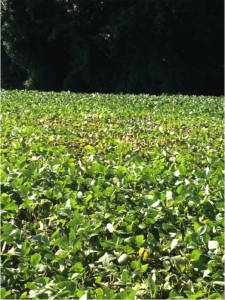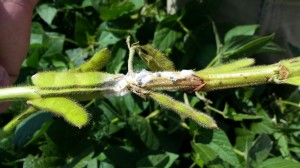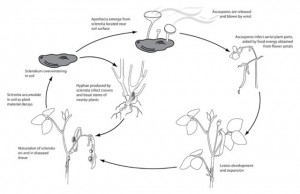
Fact Sheets And Publications
Sclerotinia stem blight (white mold) on Soybean
Sclerotinia stem blight (SSB) is common on snap and lima beans and appears sporadically in soybeans. SSB is considered a minor disease of soybeans in Delaware but it can cause significant yield loss under the right conditions. This publication will discuss disease identification, disease cycle, and management recommendations for SSB.
Disease Identification

From a distance SSB is rather non-descript. Diseased plants are typically found in patches, often in wet or shaded areas of the field. Upper leaves are often dead or plants appear wilted (Figure 1). Upon closer examination, these plants may have a white, fuzzy to granular growth on stems (Figure 2).
During dry periods these areas appear bleached and when split open, hard, black structures resembling mouse droppings (sclerotia) can be seen on and inside of stems. These sclerotia serve as the overwintering structure of the fungus. Areas that prolonged periods of dew and fog, such as along tree lines, tend to be the most severely affected as well as high-yield potential environments (i.e. narrow rows, high fertility, high plant populations).

Disease Cycle
SSB is caused by fungi with wide host ranges. Sclerotinia spp. can infect crops such as alfalfa, snap beans, potato, pepper, and tomato. In addition, weeds including amaranths, lambsquarters, Shepard’s purse, ragweed, and pigweed can serve as hosts. SSB starts when sclerotia located near the upper 2-cm of the soil surface germinate and produce a mushroom-like structures which produce millions of spores over several days’ time (Figure 3) These spores can be dispersed locally and only rarely are dispersed to other locations. Under some conditions sclerotia may germinate produce thread-like hyphae, which infect plant roots, crowns, and other low-lying plant parts.
Germination of sclerotia occurs under cool (50-68°F) periods typically following heavy rains. A 16-48 hour wet period is required for the production of spores, which are forcibly discharged and moved by air currents to susceptible plant tissue (Figure 3). Infection often takes place on flowers and once inside the plant, the fungus grows and produces stem lesions that eventually girdle the stem. Sclerotia form in or in plant tissues, where they eventually fall from plants or overwinter inside senesced stems on the soil surface (Figure 3).

Unlike foliar diseases such as Frogeye leaf spot, SSB only produces one set of infective spores per season. Plant- to-plant spread is possible if adjacent plants come into contact with diseased plants, particularly under humid conditions. Development of SSB ceases when temperatures reach around 90⁰F or the environment dries out.
Moderate air temperatures, frequent rain or irrigation, and high humidity from flowering through pod development further favor disease development. In addition, soybeans with dense canopies or rapid canopy closure tend to be most susceptible to the disease. Yield loss is often associated with disease incidence in the field. For every 10% increase in incidence at R7, yield is reduced by 2-5 bu / A.
Management
The following management practices should be followed if you have been dealing with SSB:
- Harvest fields with SSB last to avoid introducing the disease into other fields.
- Grow SSB tolerant varieties. This information can be obtained from your seed dealer.
- Long rotations to corn and small grains can help reduce inoculum by stimulating germination of sclerotia. Short rotations between corn and soybeans or other hosts can increase the buildup of inoculum over time.
- Utilize no-till. No till situations promote the germination of sclerotia and reduce white mold risk.
- Manage weeds. Some weeds are hosts of the SSB pathogen.
- Avoid excessive irrigation.
- Space rows at the widest distance that will maintain maximum yields.
During the season SSB can be managed with the use of fungicides including the MBC (FRAC group 1), SDHI ( FRAC group 7), and DMI (FRAC group 3) groups. These products are most effective is applied at R1, before symptoms develop. Fungicide applications made later than R3 or after disease is detected may not provide adequate disease control. Canopy penetration and coverage are essential to manage SSB with fungicides. Follow all label directions whenever using fungicides.
Date Published: 02/2014
Revised 8/2014
Author(s): Nathan Kleczewski Ph.D.
Extension Plant Pathologist
UD Cooperative Extension
This institution is an equal opportunity provider.
In accordance with Federal law and U.S. Department of Agriculture policy, Cooperative Extension is prohibited from discriminating on the basis of race, color, national origin, sex, age, or disability.
